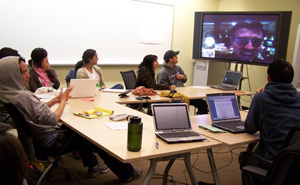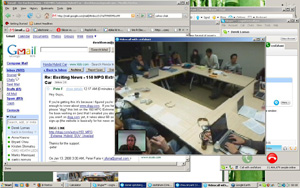UC San Diego Grad Student Connects Young Minds to India with Latest Technology
San Diego, CA, February 22, 2008 -- A UC San Diego graduate student is teaching UCSD students a class on web-based technology – not in front of the classroom, but from his remote desktop in Mumbai, India.
|
Although the course is very interactive, Derek Lomas teaches it using various forms of web-based technologies, including wiki sites, video streams and e-mail. Lomas’ course, “Design for Development: Developing Technologies for Developing Economies,” aims to connect UCSD students to the problems of the developing world. It is a practicum class with a diverse set of undergraduate and graduate students whose varied majors include engineering, computer science, economics, biotechnology and art.
Lomas received his undergraduate degree in cognitive science at Yale University and currently is in the Master of Fine Arts program at UCSD, studying social design and art and science integration. He first traveled to India in July 2007 to work for QUALCOMM Inc., but stayed because he was inspired to teach the course from an international perspective.
|
He added that one of the benefits to teaching the class from Mumbai is that he is able to provide students with a first-hand account of what life is like in India. “It increases the sense of connection to the people we are trying to serve,” Lomas said. He has been able to capture footage of the streets of Mumbai by wearing sunglasses that record video. “I am able to show them the street life by walking through crowded markets and letting students see what a rickshaw driver sees.”
|
The technology he uses doesn’t always work, yet students have been proactive throughout the course, Lomas said. Each week two students act as student seminar leaders and give presentations on topics of their own interest to the class. “One week students had to conduct the last 30 minutes of lecture without me because the connection I had in Delhi just wiped out,” Lomas said. “But when I checked back in the next day, I found that the student leaders just picked right up without me.”
Albert Lin is a Ph.D. candidate in the Department of Mechanical and Aerospace Engineering. He is taking the course because he was intrigued by its structure. “As a class, everyone is very involved,” Lin said. “It is almost as if we feel we have some type of ownership of the course because we are so committed to our projects.”
Lomas said his teaching from India is helpful for the course because, despite its economic conditions, the country has a lot of technological resources. “Seventy-seven percent of Indians live on less than 50 cents per day,” Lomas said. “Forty percent of all children are malnourished and yet half of all households have a television. There are over 250 million mobile phones and wireless coverage is nearly ubiquitous.”
Shon said she has learned what kinds of technologies are benefiting people in developing countries through the course: “We are learning what kinds of projects are successful and what technological designs help people in developing economies. I want to help the people in these areas because it’s good for everyone. We live in an interdependent world.”
Related Links
UCSD News
Media Contacts
Media Contact: Christine Clark, (858) 534-7618 or ceclark@ucsd.edu




